Mohammad Ghavamzadeh
INRIA Lille - Nord Europe
Does Thinking More always Help? Understanding Test-Time Scaling in Reasoning Models
Jun 04, 2025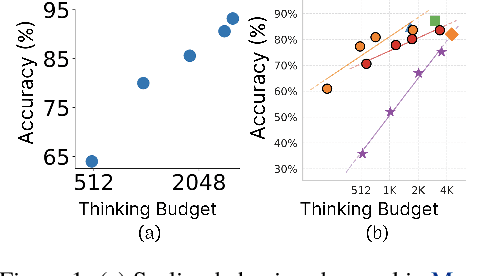
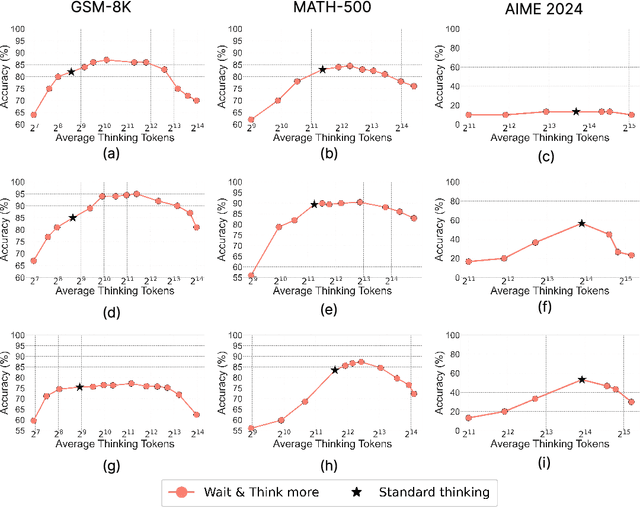
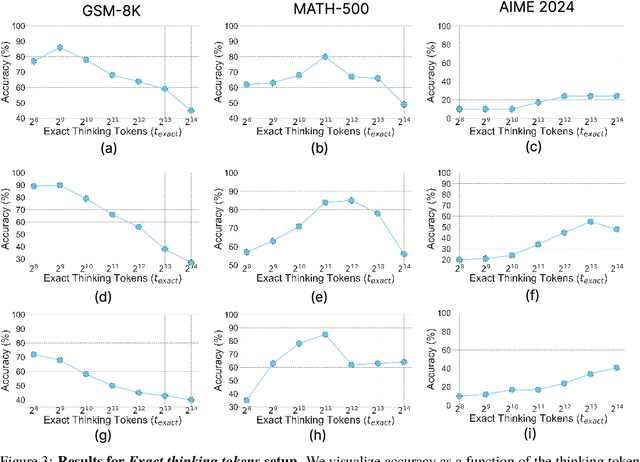
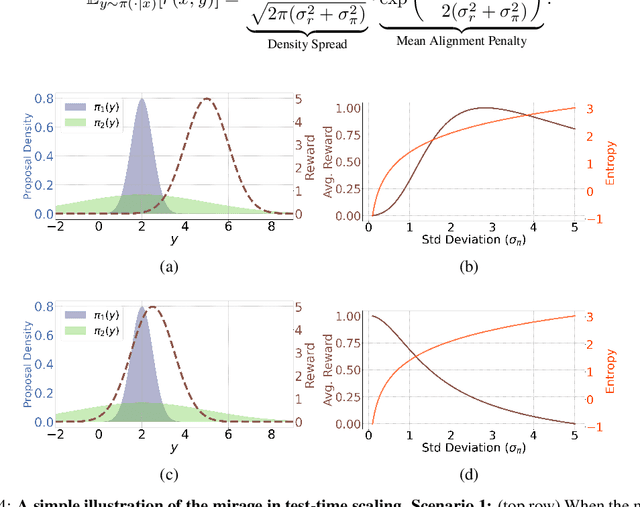
Abstract:Recent trends in test-time scaling for reasoning models (e.g., OpenAI o1, DeepSeek R1) have led to a popular belief that extending thinking traces using prompts like "Wait" or "Let me rethink" can improve performance. This raises a natural question: Does thinking more at test-time truly lead to better reasoning? To answer this question, we perform a detailed empirical study across models and benchmarks, which reveals a consistent pattern of initial performance improvements from additional thinking followed by a decline, due to "overthinking". To understand this non-monotonic trend, we consider a simple probabilistic model, which reveals that additional thinking increases output variance-creating an illusion of improved reasoning while ultimately undermining precision. Thus, observed gains from "more thinking" are not true indicators of improved reasoning, but artifacts stemming from the connection between model uncertainty and evaluation metric. This suggests that test-time scaling through extended thinking is not an effective way to utilize the inference thinking budget. Recognizing these limitations, we introduce an alternative test-time scaling approach, parallel thinking, inspired by Best-of-N sampling. Our method generates multiple independent reasoning paths within the same inference budget and selects the most consistent response via majority vote, achieving up to 20% higher accuracy compared to extended thinking. This provides a simple yet effective mechanism for test-time scaling of reasoning models.
Diffusion Blend: Inference-Time Multi-Preference Alignment for Diffusion Models
May 24, 2025Abstract:Reinforcement learning (RL) algorithms have been used recently to align diffusion models with downstream objectives such as aesthetic quality and text-image consistency by fine-tuning them to maximize a single reward function under a fixed KL regularization. However, this approach is inherently restrictive in practice, where alignment must balance multiple, often conflicting objectives. Moreover, user preferences vary across prompts, individuals, and deployment contexts, with varying tolerances for deviation from a pre-trained base model. We address the problem of inference-time multi-preference alignment: given a set of basis reward functions and a reference KL regularization strength, can we design a fine-tuning procedure so that, at inference time, it can generate images aligned with any user-specified linear combination of rewards and regularization, without requiring additional fine-tuning? We propose Diffusion Blend, a novel approach to solve inference-time multi-preference alignment by blending backward diffusion processes associated with fine-tuned models, and we instantiate this approach with two algorithms: DB-MPA for multi-reward alignment and DB-KLA for KL regularization control. Extensive experiments show that Diffusion Blend algorithms consistently outperform relevant baselines and closely match or exceed the performance of individually fine-tuned models, enabling efficient, user-driven alignment at inference-time. The code is available at https://github.com/bluewoods127/DB-2025}{github.com/bluewoods127/DB-2025.
Ordering-based Conditions for Global Convergence of Policy Gradient Methods
Apr 02, 2025Abstract:We prove that, for finite-arm bandits with linear function approximation, the global convergence of policy gradient (PG) methods depends on inter-related properties between the policy update and the representation. textcolor{blue}{First}, we establish a few key observations that frame the study: \textbf{(i)} Global convergence can be achieved under linear function approximation without policy or reward realizability, both for the standard Softmax PG and natural policy gradient (NPG). \textbf{(ii)} Approximation error is not a key quantity for characterizing global convergence in either algorithm. \textbf{(iii)} The conditions on the representation that imply global convergence are different between these two algorithms. Overall, these observations call into question approximation error as an appropriate quantity for characterizing the global convergence of PG methods under linear function approximation. \textcolor{blue}{Second}, motivated by these observations, we establish new general results: \textbf{(i)} NPG with linear function approximation achieves global convergence \emph{if and only if} the projection of the reward onto the representable space preserves the optimal action's rank, a quantity that is not strongly related to approximation error. \textbf{(ii)} The global convergence of Softmax PG occurs if the representation satisfies a non-domination condition and can preserve the ranking of rewards, which goes well beyond policy or reward realizability. We provide experimental results to support these theoretical findings.
C-3DPO: Constrained Controlled Classification for Direct Preference Optimization
Feb 22, 2025Abstract:Direct preference optimization (DPO)-style algorithms have emerged as a promising approach for solving the alignment problem in AI. We present a novel perspective that formulates these algorithms as implicit classification algorithms. This classification framework enables us to recover many variants of DPO-style algorithms by choosing appropriate classification labels and loss functions. We then leverage this classification framework to demonstrate that the underlying problem solved in these algorithms is under-specified, making them susceptible to probability collapse of the winner-loser responses. We address this by proposing a set of constraints designed to control the movement of probability mass between the winner and loser in the reference and target policies. Our resulting algorithm, which we call Constrained Controlled Classification DPO (\texttt{C-3DPO}), has a meaningful RLHF interpretation. By hedging against probability collapse, \texttt{C-3DPO} provides practical improvements over vanilla \texttt{DPO} when aligning several large language models using standard preference datasets.
Preference Optimization via Contrastive Divergence: Your Reward Model is Secretly an NLL Estimator
Feb 06, 2025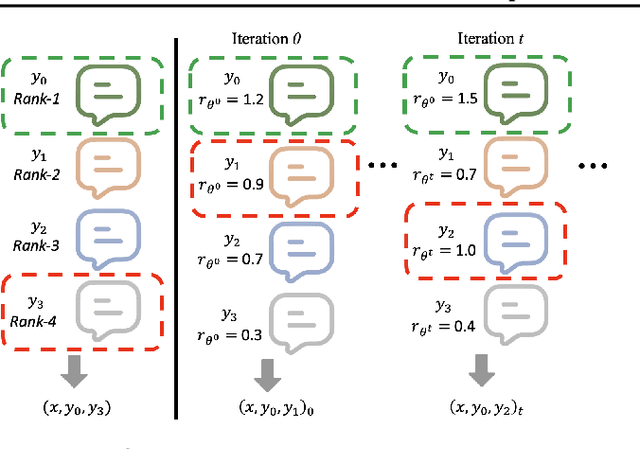
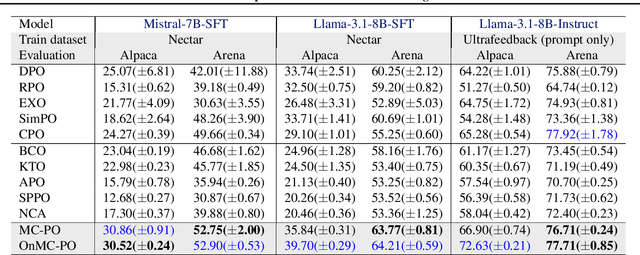
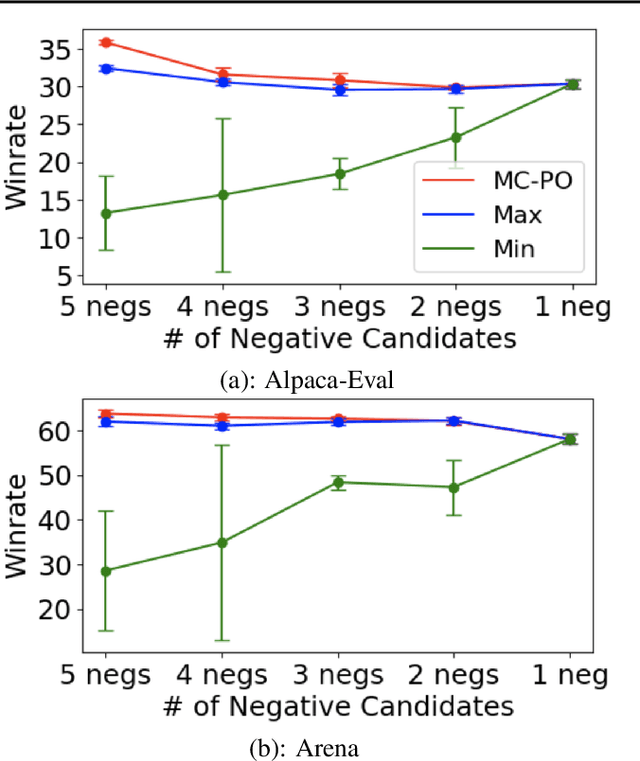
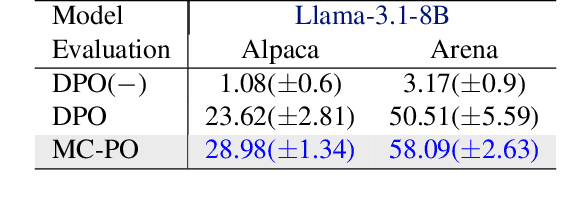
Abstract:Existing studies on preference optimization (PO) have centered on constructing pairwise preference data following simple heuristics, such as maximizing the margin between preferred and dispreferred completions based on human (or AI) ranked scores. However, none of these heuristics has a full theoretical justification. In this work, we develop a novel PO framework that provides theoretical guidance to effectively sample dispreferred completions. To achieve this, we formulate PO as minimizing the negative log-likelihood (NLL) of a probability model and propose to estimate its normalization constant via a sampling strategy. As we will demonstrate, these estimative samples can act as dispreferred completions in PO. We then select contrastive divergence (CD) as the sampling strategy, and propose a novel MC-PO algorithm that applies the Monte Carlo (MC) kernel from CD to sample hard negatives w.r.t. the parameterized reward model. Finally, we propose the OnMC-PO algorithm, an extension of MC-PO to the online setting. On popular alignment benchmarks, MC-PO outperforms existing SOTA baselines, and OnMC-PO leads to further improvement.
Conservative Contextual Bandits: Beyond Linear Representations
Dec 09, 2024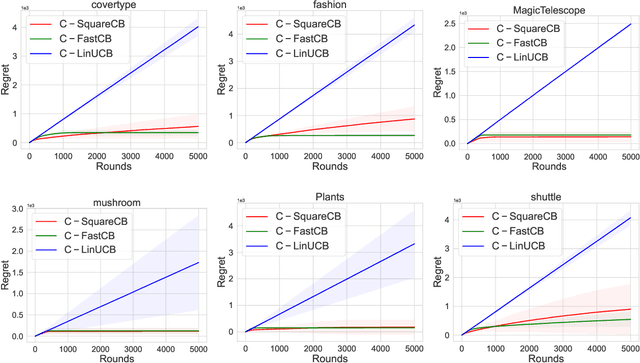

Abstract:Conservative Contextual Bandits (CCBs) address safety in sequential decision making by requiring that an agent's policy, along with minimizing regret, also satisfies a safety constraint: the performance is not worse than a baseline policy (e.g., the policy that the company has in production) by more than $(1+\alpha)$ factor. Prior work developed UCB-style algorithms in the multi-armed [Wu et al., 2016] and contextual linear [Kazerouni et al., 2017] settings. However, in practice the cost of the arms is often a non-linear function, and therefore existing UCB algorithms are ineffective in such settings. In this paper, we consider CCBs beyond the linear case and develop two algorithms $\mathtt{C-SquareCB}$ and $\mathtt{C-FastCB}$, using Inverse Gap Weighting (IGW) based exploration and an online regression oracle. We show that the safety constraint is satisfied with high probability and that the regret of $\mathtt{C-SquareCB}$ is sub-linear in horizon $T$, while the regret of $\mathtt{C-FastCB}$ is first-order and is sub-linear in $L^*$, the cumulative loss of the optimal policy. Subsequently, we use a neural network for function approximation and online gradient descent as the regression oracle to provide $\tilde{O}(\sqrt{KT} + K/\alpha) $ and $\tilde{O}(\sqrt{KL^*} + K (1 + 1/\alpha))$ regret bounds, respectively. Finally, we demonstrate the efficacy of our algorithms on real-world data and show that they significantly outperform the existing baseline while maintaining the performance guarantee.
Q-learning for Quantile MDPs: A Decomposition, Performance, and Convergence Analysis
Oct 31, 2024



Abstract:In Markov decision processes (MDPs), quantile risk measures such as Value-at-Risk are a standard metric for modeling RL agents' preferences for certain outcomes. This paper proposes a new Q-learning algorithm for quantile optimization in MDPs with strong convergence and performance guarantees. The algorithm leverages a new, simple dynamic program (DP) decomposition for quantile MDPs. Compared with prior work, our DP decomposition requires neither known transition probabilities nor solving complex saddle point equations and serves as a suitable foundation for other model-free RL algorithms. Our numerical results in tabular domains show that our Q-learning algorithm converges to its DP variant and outperforms earlier algorithms.
Confidence-aware Reward Optimization for Fine-tuning Text-to-Image Models
Apr 02, 2024



Abstract:Fine-tuning text-to-image models with reward functions trained on human feedback data has proven effective for aligning model behavior with human intent. However, excessive optimization with such reward models, which serve as mere proxy objectives, can compromise the performance of fine-tuned models, a phenomenon known as reward overoptimization. To investigate this issue in depth, we introduce the Text-Image Alignment Assessment (TIA2) benchmark, which comprises a diverse collection of text prompts, images, and human annotations. Our evaluation of several state-of-the-art reward models on this benchmark reveals their frequent misalignment with human assessment. We empirically demonstrate that overoptimization occurs notably when a poorly aligned reward model is used as the fine-tuning objective. To address this, we propose TextNorm, a simple method that enhances alignment based on a measure of reward model confidence estimated across a set of semantically contrastive text prompts. We demonstrate that incorporating the confidence-calibrated rewards in fine-tuning effectively reduces overoptimization, resulting in twice as many wins in human evaluation for text-image alignment compared against the baseline reward models.
Contextual Bandits with Stage-wise Constraints
Jan 15, 2024Abstract:We study contextual bandits in the presence of a stage-wise constraint (a constraint at each round), when the constraint must be satisfied both with high probability and in expectation. Obviously the setting where the constraint is in expectation is a relaxation of the one with high probability. We start with the linear case where both the contextual bandit problem (reward function) and the stage-wise constraint (cost function) are linear. In each of the high probability and in expectation settings, we propose an upper-confidence bound algorithm for the problem and prove a $T$-round regret bound for it. Our algorithms balance exploration and constraint satisfaction using a novel idea that scales the radii of the reward and cost confidence sets with different scaling factors. We also prove a lower-bound for this constrained problem, show how our algorithms and analyses can be extended to multiple constraints, and provide simulations to validate our theoretical results. In the high probability setting, we describe the minimum requirements for the action set in order for our algorithm to be tractable. In the setting that the constraint is in expectation, we further specialize our results to multi-armed bandits and propose a computationally efficient algorithm for this setting with regret analysis. Finally, we extend our results to the case where the reward and cost functions are both non-linear. We propose an algorithm for this case and prove a regret bound for it that characterize the function class complexity by the eluder dimension.
Maximum Entropy Model Correction in Reinforcement Learning
Nov 29, 2023Abstract:We propose and theoretically analyze an approach for planning with an approximate model in reinforcement learning that can reduce the adverse impact of model error. If the model is accurate enough, it accelerates the convergence to the true value function too. One of its key components is the MaxEnt Model Correction (MoCo) procedure that corrects the model's next-state distributions based on a Maximum Entropy density estimation formulation. Based on MoCo, we introduce the Model Correcting Value Iteration (MoCoVI) algorithm, and its sampled-based variant MoCoDyna. We show that MoCoVI and MoCoDyna's convergence can be much faster than the conventional model-free algorithms. Unlike traditional model-based algorithms, MoCoVI and MoCoDyna effectively utilize an approximate model and still converge to the correct value function.
 Add to Chrome
Add to Chrome Add to Firefox
Add to Firefox Add to Edge
Add to Edge